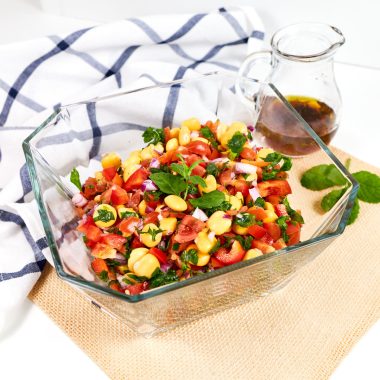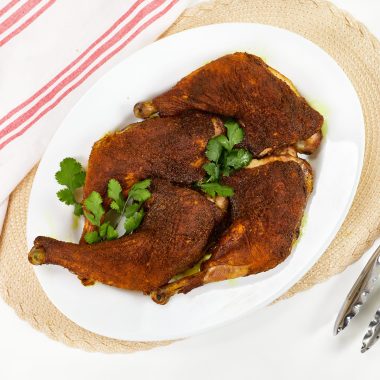Learn the best way to roast eggplant to get perfect caramelized and crispy edges while the inside stays creamy and juicy!
It’s so easy to roast eggplants in the oven – you’ll just need 3 ingredients and 30 minutes.
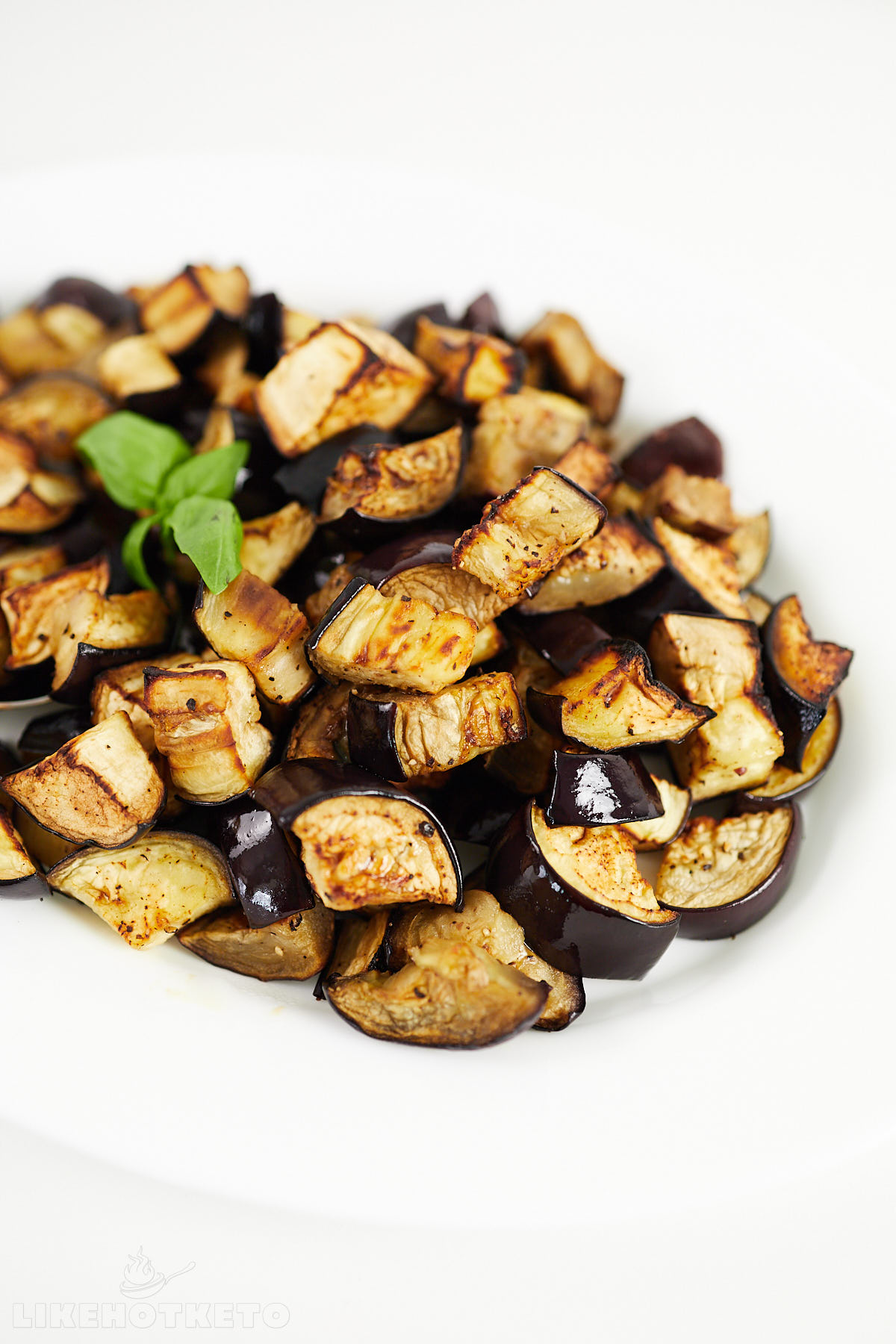
Eggplants can be pretty tasteless and bland when raw. The texture is also nothing to write home about. But roasting at high temperature with a generous amount of olive oil is the secret to unlock the best eggplant flavor!
They are so versatile: you can use roasted eggplants as a side dish, as a base for casseroles or salads or as a delicious snack with your favorite dipping sauce!
Ingredients
For this easy roasted eggplant recipe, you’ll only need the following ingredients:
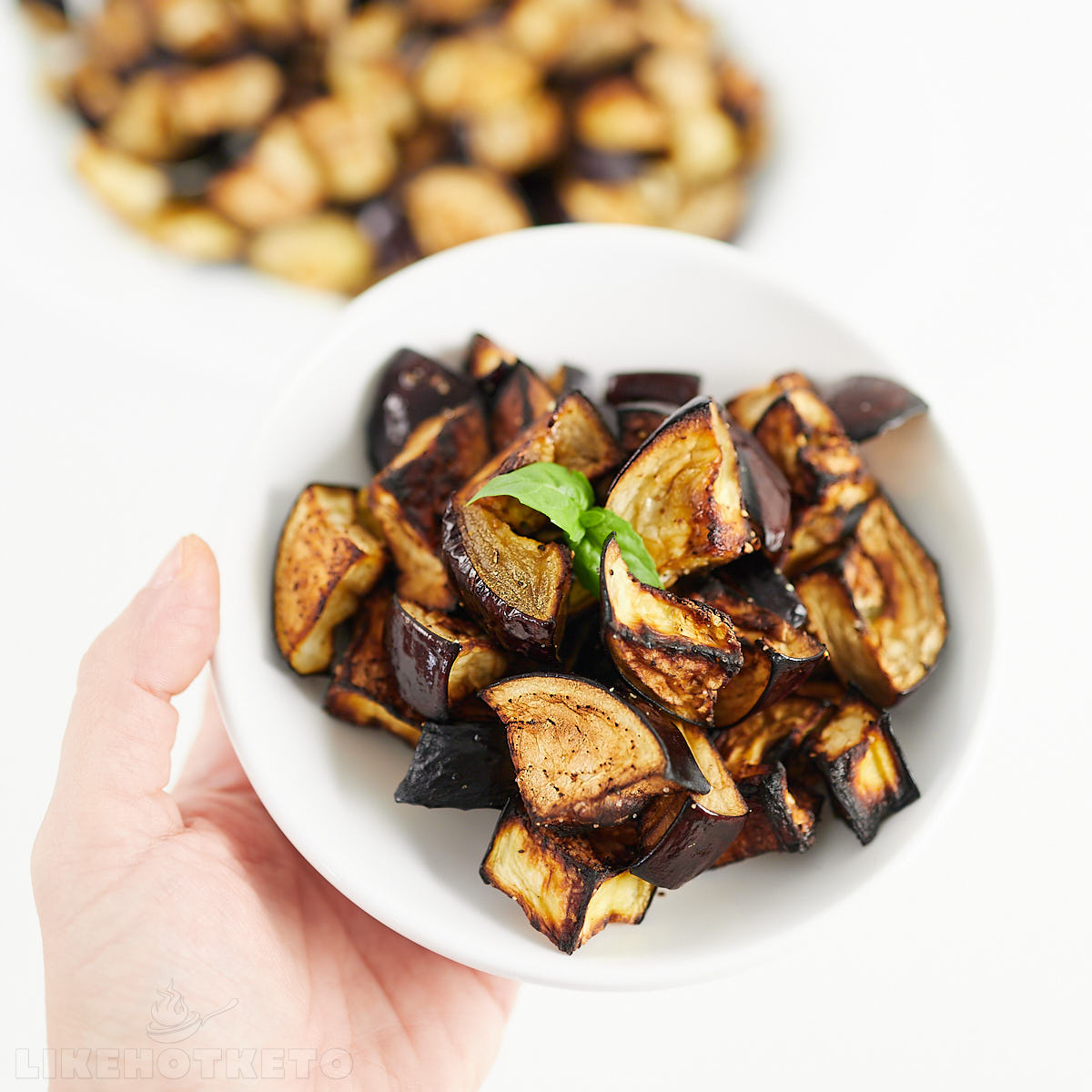
- Eggplants
- Extra virgin olive oil
- Salt and pepper. That’s it!
You can totally get creative with the spices here: believe me, you’ll be wanting to make this roasted eggplant recipe many, many times!
Read on, you’ll find plenty of ideas for variations below.
What’s the best eggplant for roasting?
The globe eggplant variety, which is the most common type of eggplant available in the US, is great for roasting. It has a meaty flesh and not so bitter taste.
The globe eggplant is also called American eggplant. Other good eggplants for roasting are the Italian eggplants, Japanese eggplants and Rosa Bianca eggplants, so you can also use these in this recipe.
To help you figure out which eggplant variety you have (or would rather buy), here’s a quick guide:
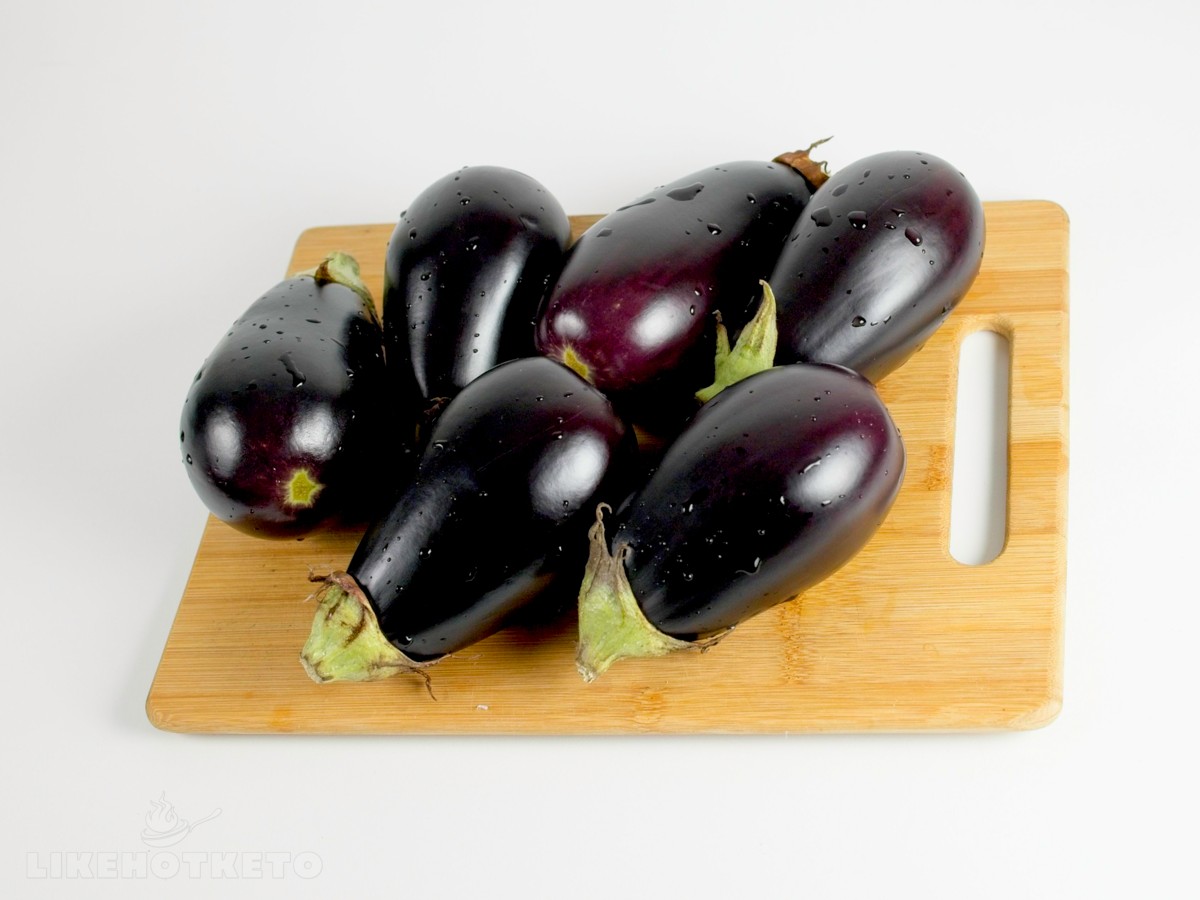
- Globe or American Eggplants are large, round or oval-shaped, and usually have a deep purple or black skin. The taste is a mild and slightly bitter. They can be used in a variety of dishes, such as eggplant parmesan or ratatouille.
- Italian Eggplants are generally smaller and more elongated than globe or American eggplants. They have a dark purple or black skin and a slightly sweeter flavor. Italian eggplants are often used in Mediterranean dishes and are well-suited for grilling or roasting.
- Japanese Eggplants are very small and slender. They have a thin skin, which is often shades of purple, and a sweet, delicate flavor. Japanese eggplants are commonly used in Asian cuisine and are great for stir-frying and grilling.
- Rosa Bianca eggplants are a unique variety with a creamy white to pale pink skin and a medium-sized round to oval shape. They have a mild, sweet flavor with a creamy texture. Rosa Bianca eggplants are popular for their ornamental appearance and are often used in Italian and Mediterranean dishes.
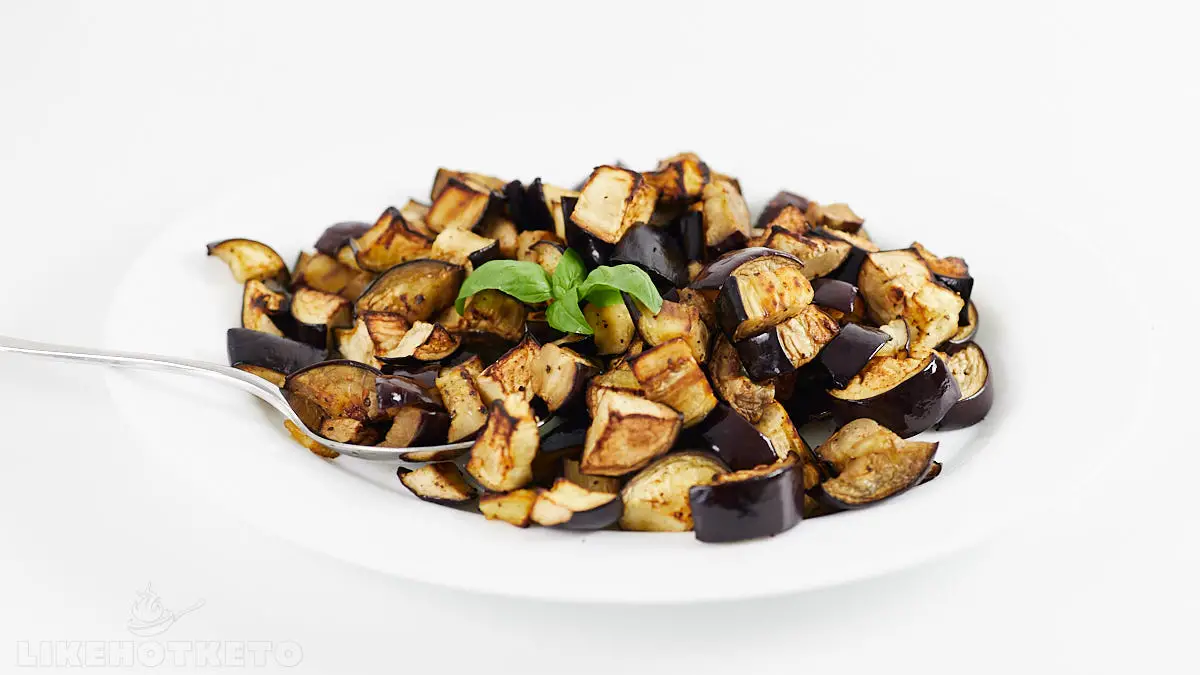
A guide to choosing eggplants
When picking and buying eggplants at the grocery store there are a few key factors to consider to ensure you choose the best ones.
Here’s 6 hot tips for picking the best eggplants for roasting:
1. Size and Shape: Choose eggplants that are medium-sized and have a smooth, shiny skin. Avoid eggplants that are too large, as they might be overripe and have more seeds.
Also, avoid ones that are too small, as they may lack flavor and have a bitter taste. Look for eggplants that have a uniform shape and are free of wrinkles, blemishes, or cuts.
2. Color: The color of the eggplant skin is an important indicator of ripeness and flavor. Look for eggplants with deep, vibrant colors.
The typical dark purple variety is most common, but you may also find other shades such as light purple, white, or even striped. Avoid eggplants with dull or faded colors, as they may be overripe or have poor flavor.
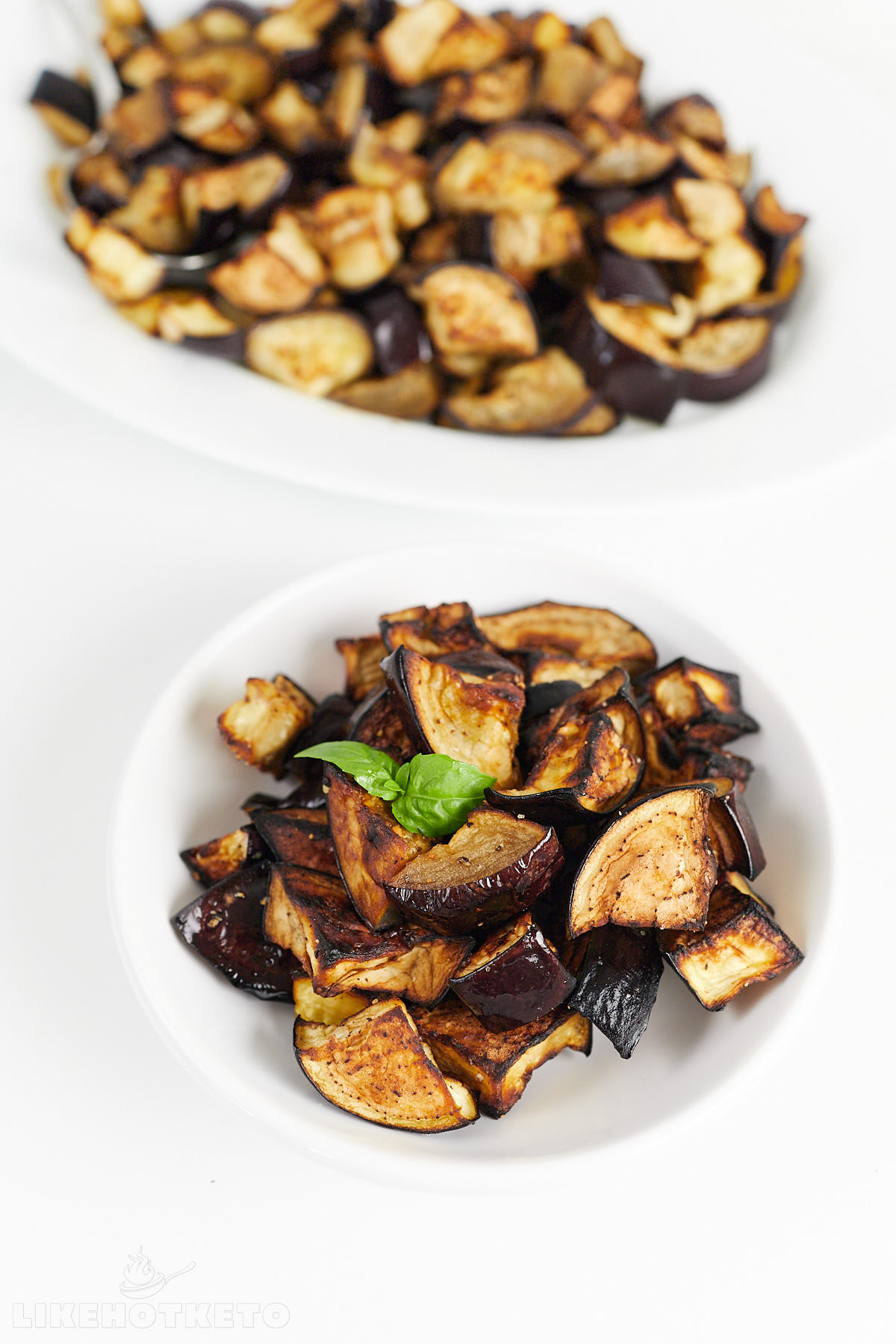
3. Weight: Pick up the eggplant and feel its weight. It should feel relatively heavy for its size. Heaviness indicates that the eggplant is fresh and has a good moisture content.
4. Stem: Check the stem of the eggplant. It should be green and fresh-looking. Avoid eggplants with dried, brown, or withered stems, as this can indicate older produce.
5. Firmness: Gently press the eggplant with your fingertips. It should be firm but slightly yielding. If it feels too soft or mushy, it might be overripe.
6. Variety: As I mentioned above, different eggplant varieties have slightly different flavors and textures. Feel free to experiment with different varieties to find the ones you enjoy the most.
How to pick eggplants with less seeds
While it’s not always possible to tell how many seeds an eggplant has without cutting it open, you can gauge the seediness by feeling the bottom end (opposite the stem).
A round, smooth bottom suggests the eggplant has fewer seeds, while a flat, irregular bottom might indicate more seeds.
The reason why? Male eggplants are the ones with a smoother, rounder bottom. The other ones are the female eggplants, which obviously have more seeds. They are also more likely to be bitter.
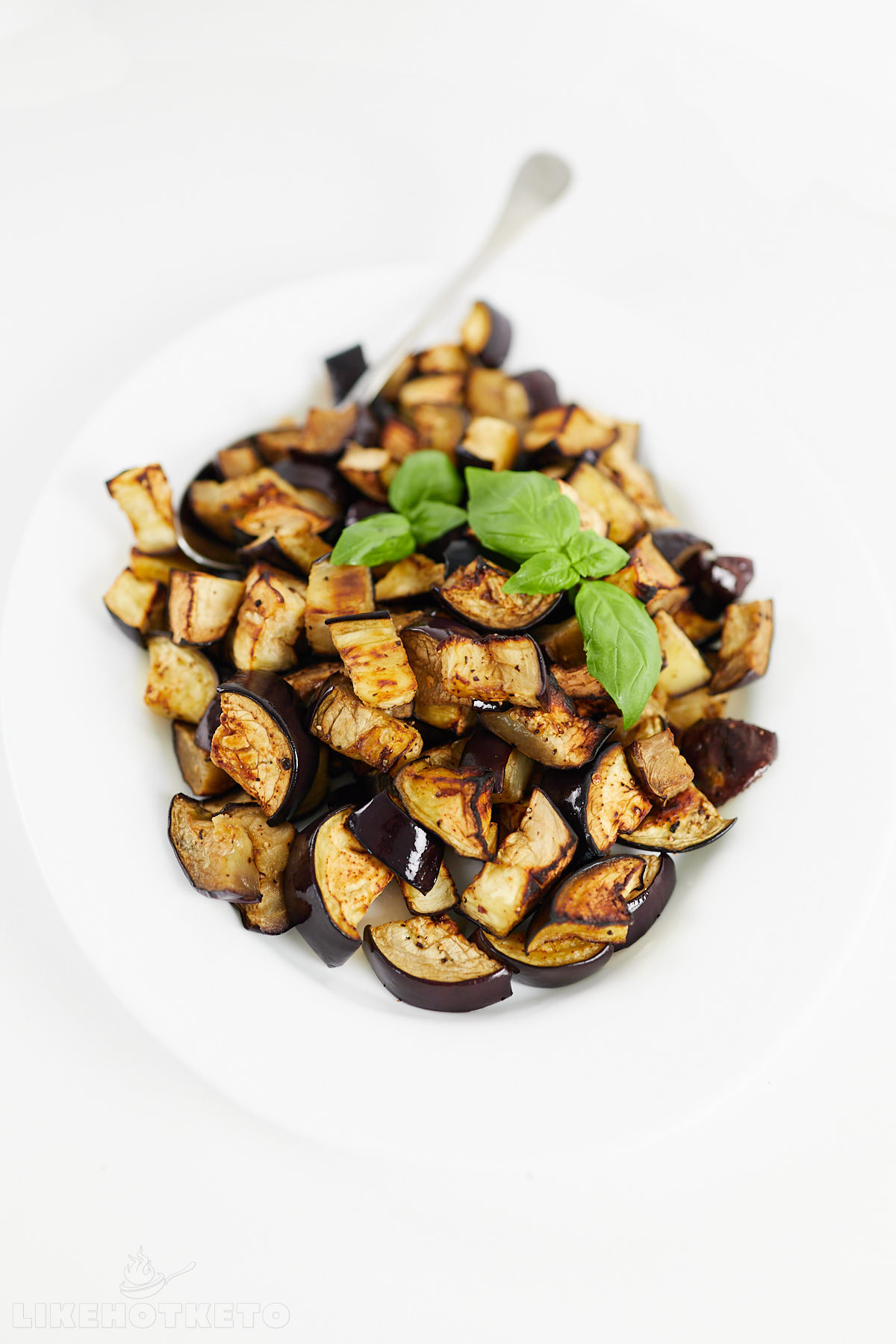
How to cut eggplant
For this roasted eggplant recipe, I cut them into cubes. But there’s many other ways to cut eggplant for roasting:
You can just slice them in the middle, longitudinally like boats. This method is good for making stuffed eggplants. Or, you can slice them into rounds, or half-moons, or triangles.
You can follow this recipe to make roasted eggplant in any of these shapes, you’ll just need to adjust the cooking time. Larger pieces of eggplant will take a bit longer to roast. The results will be the very delicious same!
How to roast eggplant in the oven
1. Preheat the oven to 450 °F (230 °C) and line the baking sheet with parchment paper. This will keep the eggplants from sticking and make clean-up a breeze!

2. Wash the eggplants well to remove dirt and pesticides. I always gently scrub them with my tawashi brush.
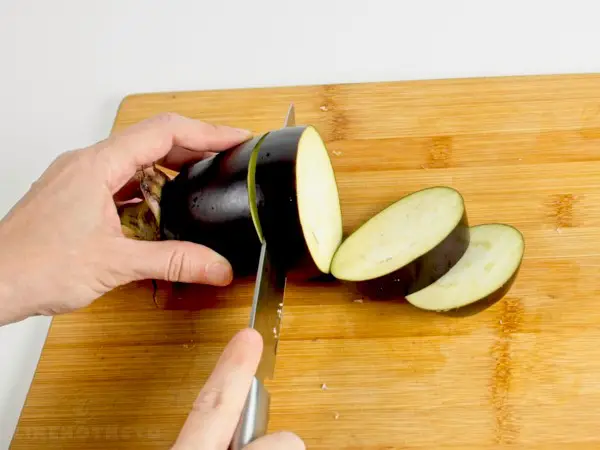
3. Hold the eggplants by the leafy end and cut them into slices a little over 1″ thick.
After slicing them into rounds (step 3) you can use the following cutting technique to make the cubes uniform in size:
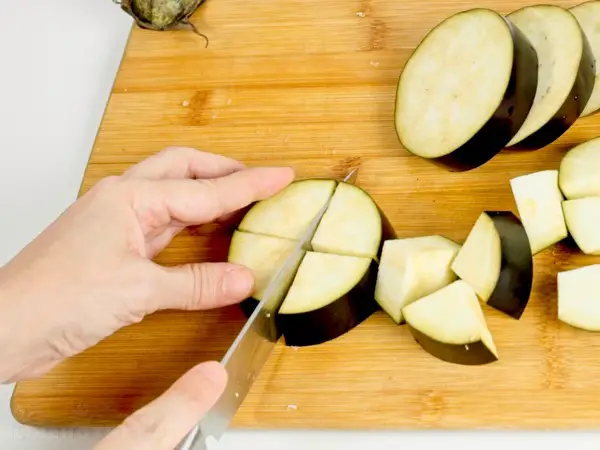
4. Cut the smaller (narrower) slices into four cubes.
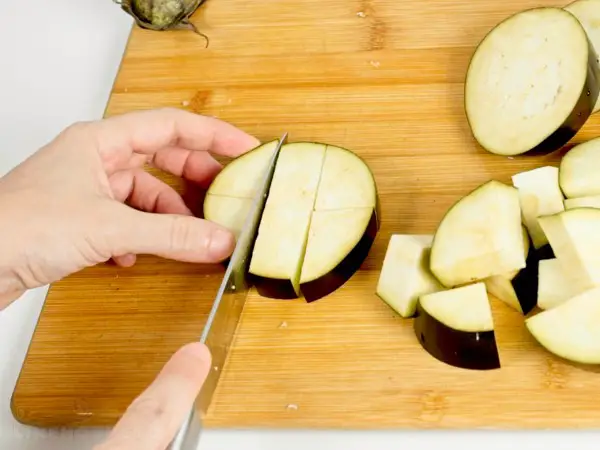
5. Cut the larger (wider) slices into six cubes.
There, now you have an evenly cut and cubed eggplant! This method of slicing eggplants works great even if your eggplants are much wider at the bottom than at the top, like globe eggplants usually are.
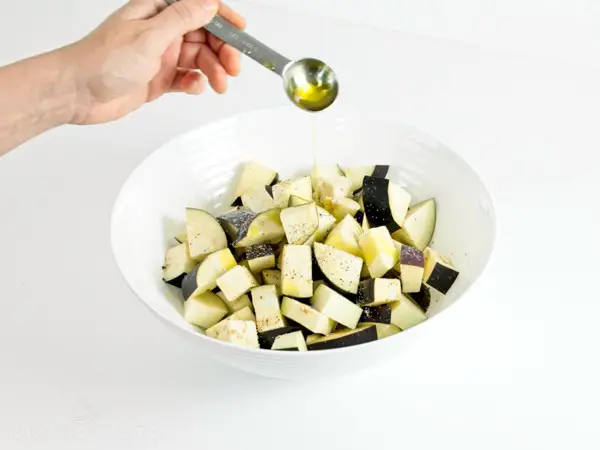
5. Season the eggplant cubes with salt and pepper, and drizzle them with olive oil.
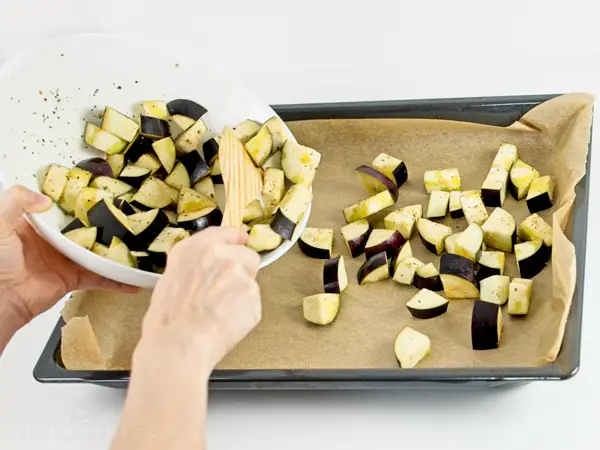
6. Spread the eggplants evenly on the lined baking sheet in a single layer.
Hot tip: Eggplant pieces absorb olive oil like a sponge! Be quick while drizzling and toss the cubes around for the olive oil to spread evenly.
Alternatively, you can use an olive oil spray. It’s much easier to coat all the eggplant as it creates a fine mist. I use this refillable oil spray, so I can put my favorite olive oil inside and always have it on hand when I need it.
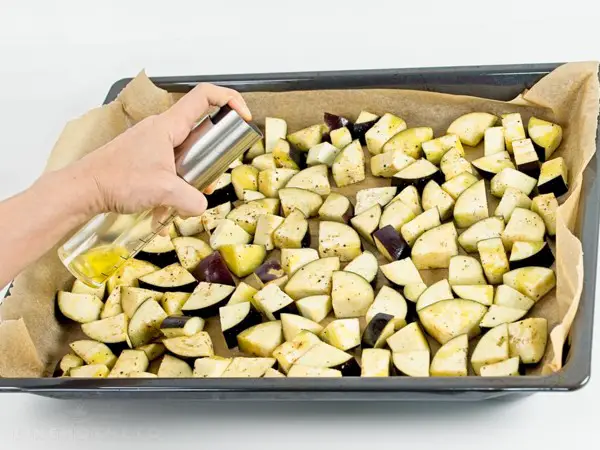
7. Feel free to spray a bit more of olive oil for good measure.
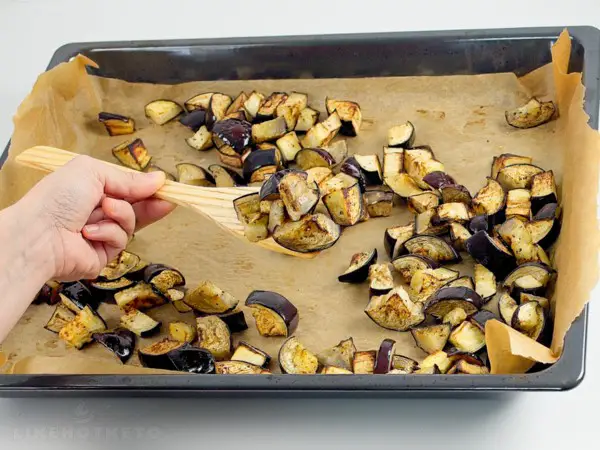
8. Roast the eggplants at 450 °F (230 °C) for about 30 minutes.
Stir them once after about half of the cooking time has elapsed for even browning.
You can choose at which point you’ll remove the eggplants from the oven, it depends on how cooked you like them
I like my eggplants really caramelized, so I leave them for much longer than it’s actually needed to soften them.
These are some approximate time ranges for how long you should roast the eggplants according to your taste:
Softened and golden: About 25 minutes at 450 °F (230 °C).
Fully caramelized and browned: 30 to 35 minutes at 450 °F (230 °C).
Tips for the best roasted eggplant
Follow these simple tips to get perfect roasted eggplants every time:
- Cut large pieces: At least 1-inch cubes or larger so they will stay tender and juicy with caramelized edges. If you you cut the eggplant into small pieces, they will either dry out or turn into mush before they get caramelized.
- Even sized pieces: Cut the eggplant in similar sized cubes. If the eggplant in cut into uneven sizes, they will cook at different speeds. By the time the large pieces are tender, the smaller ones will be burned. Uniformity is the key!
- Lined pan: Parchment paper on the bottom of the pan is a must to ensure no piece of eggplant will stick to the bottom, and for easy clean up.
- Don’t skimp on the olive oil: Olive oil brings out the richness of the flavor and helps caramelize and soften the eggplants. Drizzle generously.
- Hot oven: The heat will seal the outside of the eggplant and stop the juices from evaporating, keeping them succulent and flavorful. It’s the same premise as cooking steak!

Spice variations
These roasted eggplants are just heavenly with the simple addition of salt and pepper, but there’s nothing wrong with stepping up on the spice selection! Here’s a ton of flavor variation ideas:
Mediterranean roasted eggplant: Add minced or powdered garlic and dried oregano along with olive oil, salt, and pepper. A sprinkle of lemon zest after roasting can also add a refreshing citrus note.
Spicy roasted eggplant: Mix in smoked paprika, cayenne pepper, or crushed red pepper flakes to give the dish a kick of heat.
Cumin-spiced roasted eggplant: Combine ground cumin, ground coriander, and a pinch of ground cinnamon with the olive oil, salt, and pepper. These warm spices will add depth of flavor.
Herb-infused roasted eggplant: Toss the cubed eggplants with chopped fresh herbs such as rosemary, thyme, and basil before roasting. The aromatic herbs will infuse the eggplant with a fragrant aroma.
Indian-inspired roasted eggplant: Use a blend of ground turmeric, ground cumin, ground coriander, and a pinch of garam masala. This will give the eggplant a warm, earthy, and slightly spicy flavor.
Asian-Inspired roasted eggplant: Combine soy sauce, grated ginger, and a touch of sesame oil with the olive oil, salt, and pepper. Top with chopped green onions and sesame seeds after roasting.
Italian roasted eggplant: Sprinkle dried basil, dried thyme, and a bit of grated Parmesan cheese over the eggplant before roasting for a classic Italian flavor profile. Great to serve with Italian meatballs!
Za’atar roasted eggplant: Toss the eggplant cubes with za’atar spice blend (a mixture of dried thyme, sumac, sesame seeds, and salt). It will impart a tangy and aromatic Middle Eastern flavor.
Remember to adjust the quantities of spices according to your personal taste preferences. You can also experiment by combining different spice variations to create your own unique flavor!
Do you have to peel the eggplant before cooking?
No, you don’t need to peel eggplant before roasting them. The purple eggplant peel helps hold it together as it softens during cooking. So it’s better to leave the peel on for this recipe.
If you don’t like the skin on the eggplant, you can peel “zebra stripes” on it before cutting. To do this, you just need to shave off ribbons of skin lengthwise, in an alternating pattern.
By cutting the zebra stripes you are removing about half of the skin, but leaving enough on so that the eggplant pieces won’t collapse into mush.
The only scenario where you should fully peel the eggplant before cooking is if you’re planning to make an eggplant puree dish, like baba ganoush.
Do you need to salt eggplant first?
It’s not necessary to salt the eggplant in most cases.
In the past, it was customary to salt eggplants to help remove their bitterness.
Eggplants are now bred to be less bitter, so if you buy your eggplants from a supermarket it’s very unlikely that they will need to be salted.
Still, some varieties can have some bitterness to them, or if you buy large or older eggplants they might have developed some bitterness. So, you can salt them if you like.
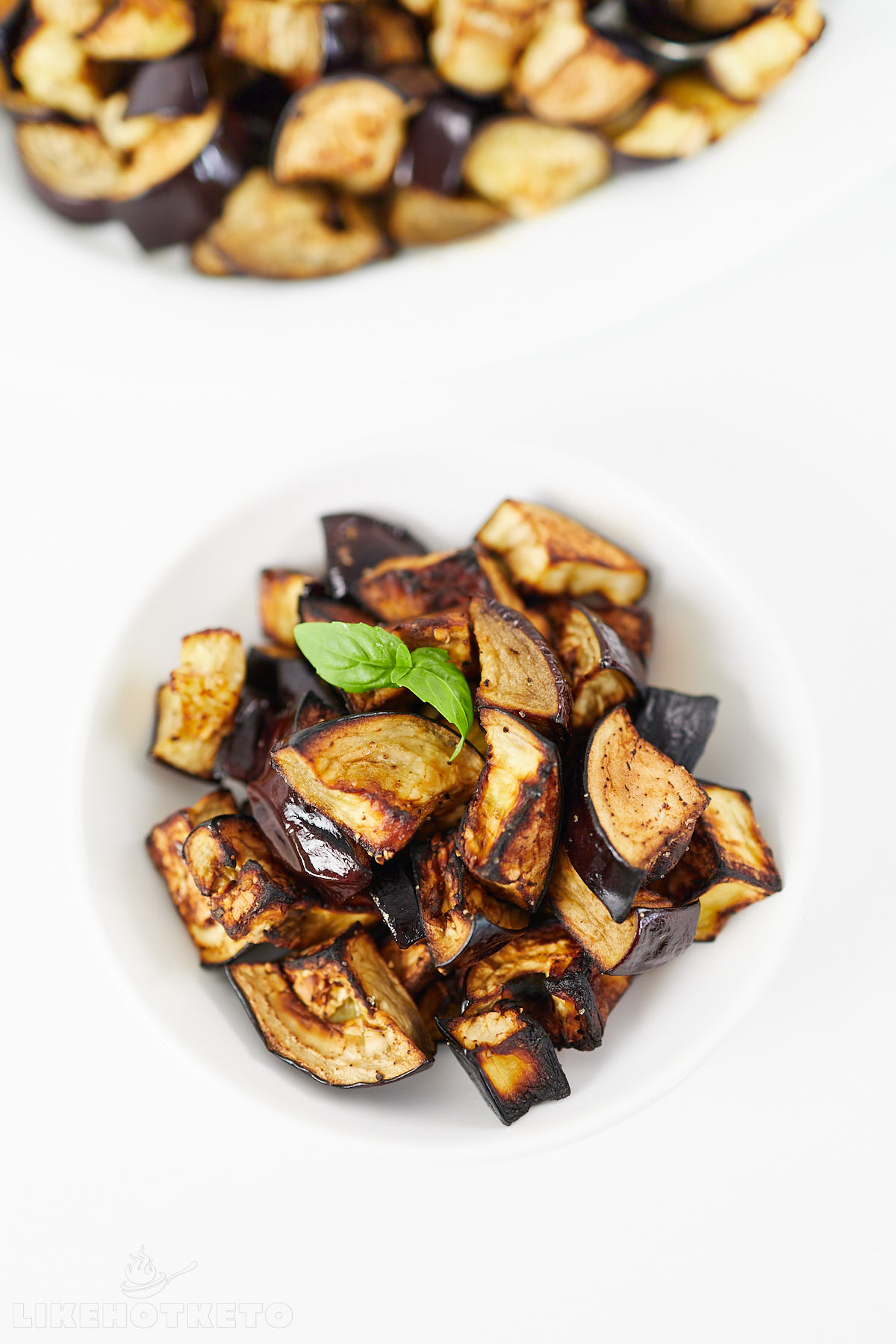
How to salt eggplant to remove bitterness
After slicing the eggplants, put them on a colander over the sink. Sprinkle them generously with salt (about one teaspoon per eggplant).
The eggplants will start sweating which will drain them of excess moisture, also removing most of the bitterness in the process.
Leave the eggplant draining for at least one hour, or even overnight. The longer you salt the eggplants the most bitterness will be removed.
After salting the eggplants you need to rinse them well to remove the excess salt, and them pat them dry with paper towels.
The eggplants are now ready to make the recipe as written. Just be careful, you don’t need to add any more salt. Add any other spices as you wish.
What to do with roasted eggplant
Roasted eggplants by themselves make a great side to be served along a variety of main dishes. It pairs especially well with Middle-Eastern, Italian and Mediterranean inspired main dishes.
You can use roasted eggplant cubes in salads, casseroles, wraps and bowls.
You can also just enjoy the roasted eggplants cubes as a healthy and filling snack! Here’s some ideas:
- Toss the roasted eggplants with some balsamic vinegar and add a sprinkle of shaved Parmesan or freshly grated mozzarella.
- Squeeze some lemon juice over the roasted eggplants and add some crushed feta or roasted halloumi cheese cubes. Garnish with some fresh basil or mint leaves.
- Just serve them along your favorite dipping sauce for a tasty and healthy low-carb snack!
Some sauces and dips that go great with eggplant are marinara (try this 2-minute homemade recipe!), tahini sauce, aioli or even ranch dip sauce!
Storage
Roasted eggplant tastes best fresh from the oven. If there are left overs, keep them refrigerated in an airtight container for 2 to 3 days.
Reheat the baked eggplant in the oven at 350 °F (175 °C). Remove as soon as they are warmed up to prevent them from burning.
You can also reheat them in the microwave, but they will get too soft (they will lose the crispness).
I do not recommend freezing the roasted eggplants, as the texture is not as good when thawed and reheated.
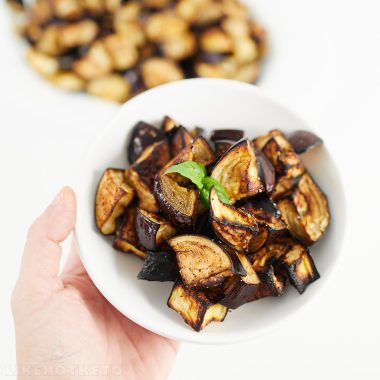
Perfect Roasted Eggplant
Equipment
Ingredients
- 2 eggplants 2 medium or 3 small, about 1 1/2 pounds (700 grams)
- 4 tablespoons olive oil
- ½ teaspoon sea salt
- ½ teaspoon black pepper
Instructions
- Preheat the oven to 450 °F (230 °C) and line a large baking sheet with parchment paper.
- Wash the eggplants and pat them dry. Holding by the stem, cut them into slices a little over 1" thick. Cut each slice into 4 or 6 cubes. Cut similar sized pieces for uniform browning.
- Place the eggplant cubes in a large bowl. Add salt and pepper. Drizzle or spray olive oil evenly and toss well to spread the seasonings.
- Spread the eggplant pieces on the lined tray on a single layer, and take it into the oven at 450 °F (230 °C). After 15 minutes, flip the eggplants and return them to the oven for another 10 to 15 minutes, until they are tender and golden brown.
Notes
Nutrition
Copyright Pris Frank for LikeHotKeto. Please DO NOT SCREENSHOT OR COPY/PASTE recipes to social media or websites. We’d LOVE for you to share a link to this recipe instead 🙂 Try the easy sharing buttons below!
